
In 2128, after years of global warfare, theoretical physicists joined together with astronomers, engineers, and particle physicists to announce a breathtaking breakthrough: the ability to create new Earths.
Instead of warring over ever-scarcer resources and ever-diminishing supplies, factions and populations could transport to a verdant Earth, untouched by humans. With great fanfare, the colonists departed for the first earth clone created, ready to leave war behind.
It took two months for the first battle to take place. It turns out that factions weren't so ready to share, to give up past grudges, or to forgive trespasses.
As future Earths were colonized, future wars followed.
You have one of these Earths. It is waiting for your story, your wars. As of now there are no cities, no wars, even the continents are unnamed.
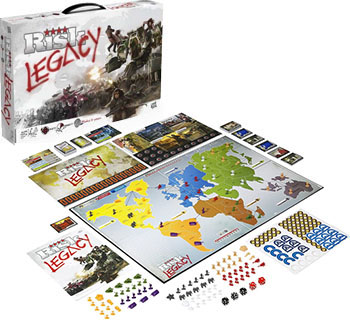
Components
- Gameboard
- 5 Dice
- 175 Cards
- Army Cards
- 275 Military Units
- Parts Sheet
- Instructions
Risk Legacy is different
This is a game where the choices you make in one game end up affecting future games, where actions have consequences, where you shape the history of your world.
We're going to ask you to write on your game, to mark it, put stickers on it, and even to throw away parts of it. In fact, that's how the game works. What you'll end up with is a game that has been through a war- your war.
No two games will be close to the same. Each will have its own history, its own weaknesses and strengths, and its own heroes.
The early games you play in this world will be somewhat simple and straightforward (for a Risk game). But the choices you make in those games will echo throughout future ones. As you get further into the wars, more and more richness will come into play.
You've probably already noticed that there are a number of envelopes and compartments that are sealed off. They'll get opened and their secrets will be revealed as you play the games. We know that you could rip them all open right away, but you'll enjoy it more if you wait for the right moment.
It'll be worth it. You'll also see that many sections of the rulebook are blank. New rules will come into play as games progress on this world.
Your Factions
-

Die Mechaniker
Heavily armored and highly defensive, Die Mechaniker rely on surviving what their enemies throw at them.
-
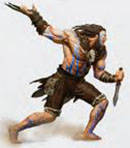
Enclave of the Bear
Savage and primal, the Enclave of the Bear are genetically altered humans who terrify their enemies with their ferocity.
-
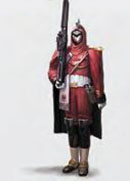
Imperial Balkania
Pure humans who are organized and diligently trained. The Imperial Balkanians want to spread their world vision to this new planet.
-
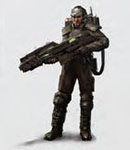
Khan Industries
Well-armed but not well-trained, Khan Industries is overpopulated with members from all genetic backgrounds. Their motto: people and guns are cheap to make.
-
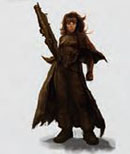
The Saharan Republic
Savvy warriors who fight with old equipment and guerilla-like tactics. The Saharan Republic exists to be mobile and hard to find.
Game Elements
Gameboard
The game board is divided into 42 territories. Troops will go in these territories. Sometimes there will be many troops in a territory; sometimes none.
-
Territories are connected either by a border or by a sea-line. Territories that are connected can attack each other. There is no difference between attacking over a sea line or across land.

-
Territories are grouped together into six different continents. The territories are marked in different colors to show which continent they belong to. If you control a whole continent at the start of your turn, you'll get bonus troops.
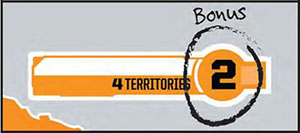
-
The top of the board defines the abilities of some of the marks. The game starts with two scars (Bunker and Ammo Shortage) and the fortification mark available. The blank spaces on the board will get filled in as you open envelopes.
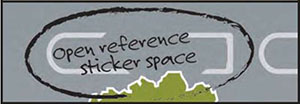
-
Each territory has a shape showing you where to place marks in that territory. Scars connect to the lower half and cities connect to the upper half. By placing them on the symbols, you make sure that you don't accidentally put two scars in the same territory or cover up a name or put a sticker over a fold in the board, etc.
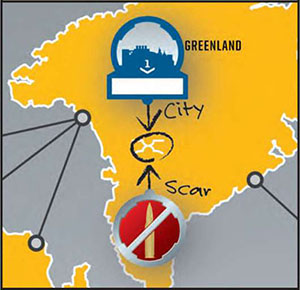
-
The final thing to note is the victor's section. The winners of the first 15 games on this board will get to sign this section and will receive a game-altering reward for winning.

Faction Cards
Each army comes with its own Faction card that will evolve as you play more games. The back of the card shows where each Faction started a game (if it was in that game) and whether it won, held on, or was eliminated.
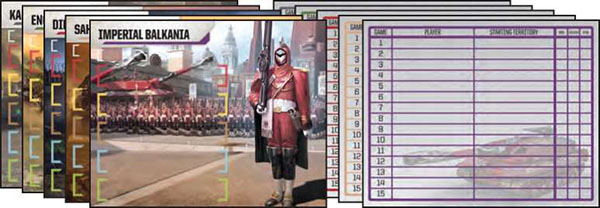
Plastic Pieces
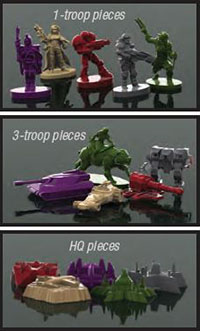
The plastic figures represent troops and HQs.
There are two different types of troops: the single figure represents one troop; the vehicle/mounted figure represents three troops.
It makes no difference if you put three single troops or one 3-troop piece in a territory - either option represents three troops.
The last plastic piece is a faction's HQ. Each HQ is worth one red star (you need 4 red stars to win the game so it is good to hold onto your HQ and to take other players').
Sideboard
This is the sideboard where you will place the different types of cards in the game. The sideboard helps you manage the cards. Place the sideboard to one side of the gameboard.
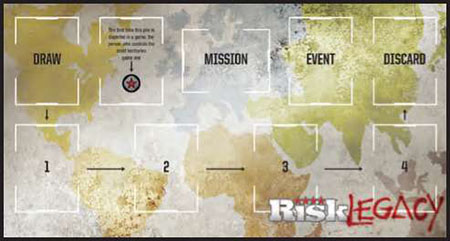
Dice
You have dice in two different colors. The 3 black dice are used when attacking. The 2 red dice are used when defending.
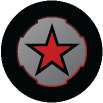
Red Stars
These are used to keep track of Red Stars that players have earned in the game.
Missiles
Players receive one missile for every game they have won in this world.
Cards
-
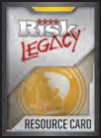
Resources/Resource Cards: There are two types of resource cards in the game: Territory cards and Coin cards. They both have Coin symbols on them that represent resources.
-
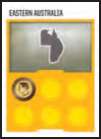
Territory Cards: Each Territory card has a name of a territory on it and one Coin symbol on it at the start of the game. As you play more games, Territory cards will get more resources (Coins), up to a maximum of 6.
-
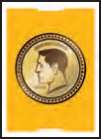
Coin Cards: There are 10 Resource cards that only have the Coin symbol on them. These are Coin cards. Coin cards form a separate pile on the board and are never upgraded to have more than one resource (Coin) on them.
-
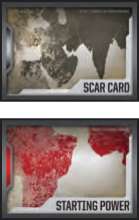
Scar Cards: Players will receive a Scar card before some games. These will allow the player to permanently alter a territory on the board or a Faction card.
Starting Power Cards: These cards are used to give the Factions one starting power.
Other cards will come into play as you open the sealed components.
Sealed Components
Don't open these until you've earned the right to!
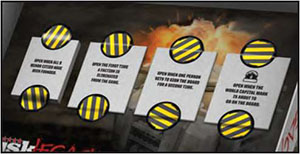
Object of the Game
You win immediately when you are the first player to have 4 Red Stars, or if all other players are eliminated.
Red stars can be gained in several ways:
Players who have not yet won a game on this board start with one Red Star token.
Every HQ you control counts as a Red Star. Taking over other players' HQs is one way to gain more red stars (note: you do not collect a Red Star from the pile, every HQ counts as a Red Star).
Red Star tokens can be purchased at the start of your turn by turning in 4 Resource cards (regardless of the number of coins on those cards).
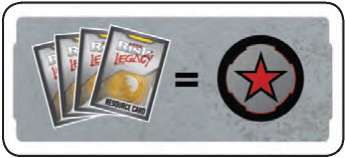
There are other ways to gain Red Stars that will come into the game the more you play it. These will be explained at that time.
A player's current Red Star total is equal to the number of Red Stars he controls on the board, plus the number of Red Star tokens he has in front of him.
Red Stars on the board (HQs and other things later in the game) can change hands many times in a game but Red Star tokens never change hands.
Setup
Before your first game
Before you start your first game you will customize your world and your factions. There's no right or wrong way to do this. You can think it through or do it randomly. One person can do it or it can be a group decision.
Customize the Factions
Each Faction has two possible starting powers. Take the First Game Power cards and choose a starting power for each Faction. Remove the sticker from the card and put it onto the green space of the corresponding Faction card.
Once each Faction has a starting power, DESTROY the remaining powers; they will not come into play in your version of the game. If you are stuck as how to customize the cards, flip a coin for each faction's starting power.
Customize the Resource Deck
Each Territory card starts with one coin on it, showing it has one resource. The section on the sticker sheet marked BEFORE YOUR FIRST GAME contains 12 additional coins to be placed onto Territory cards.
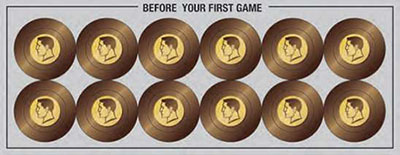
Remove the 12 Coin stickers from the card and apply them to the Territory cards. You cannot increase a territory's starting resources beyond 3 before the first game (after the first game a territory card may be slowly increased to 6 resources).
Note: Increasing a territory to 3 resources before the first game will make those territories hotly fought over. Keeping all of them at 1 or 2 resources will spread the board out.
Similarly, increasing the value of the territories in one continent will make that continent very valuable whereas spreading out the resources will give the whole board its spots worth fighting over.
There is no right or wrong way to do this but different choices will lead to a different flavor of game. If you can't decide, shuffle the Territory deck, and put one coin on the first 12 cards drawn randomly from the top.
Sticker Cards
As you play games of Risk Legacy, you will gain access to different cards that have stickers on them (like Scars). Whenever a sticker card no longer has any stickers, it is DESTROYED.
Setup before every game
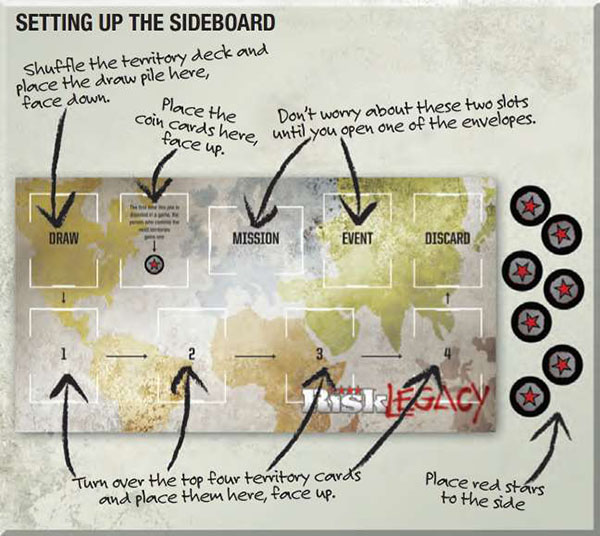
Player Set Up
Players start each game with either:

If you haven't signed the victor's section of the board (you sign that when you win a game), take a Red Star token.
If you have signed the victor's section, take one Missile token for every time your name is on that area of the board.

Scars Cards
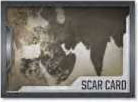
Shuffle the available Scar cards and randomly deal ONE to each player. If there aren't enough cards for every player to get one, then no one gets a Scar card for this game.
There will likely be a few games where there aren't enough (or any) scars to deal out but more Scar cards will come into the game as you open some of the sealed components.
Before the first turn
Before selecting your Faction, it's important to note where you can start on the board.
A legal starting territory is either:
- An unoccupied territory that has no marks (no scars or cities) OR
- An unoccupied territory that contains a Major City that you founded in an earlier game, (even if it has a scar on it).
Note: At the start of the game, you cannot place your HQ adjacent to another faction's HQ.
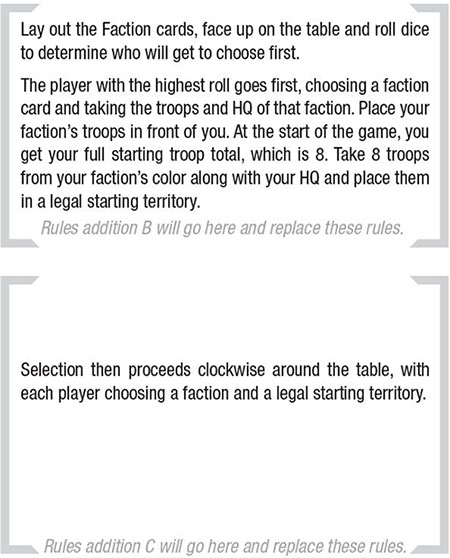
After all starting troops and HQs are on the board, players write their name and starting territory on the back of their faction cards for the current game being played. (If you are unsure which game number this is, check the signed victors section of the board).
Factions not chosen for this game should have an "X" marked on the back (under player) for this game to show that they did not take part, and then returned to the game box.

The player who placed first takes the first turn, with play proceeding clockwise.
Rules addition D will go here and replace these rules.
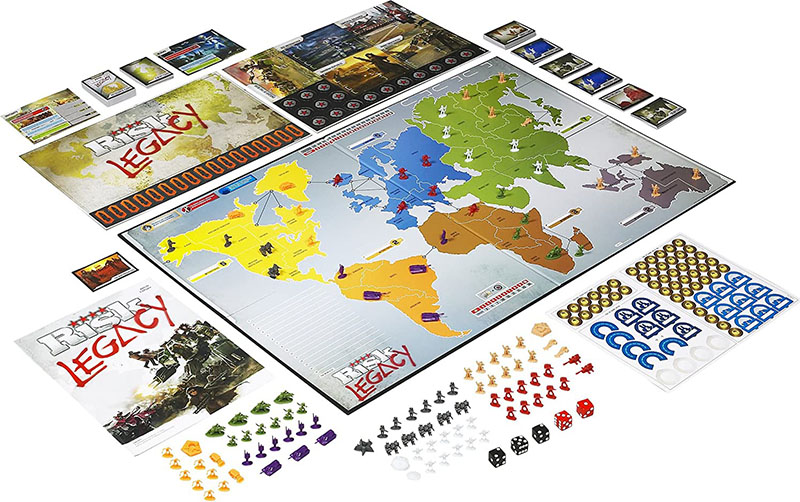
Game Play
Each player will take his turn using the following steps, in order. After a player has completed their turn, the player to the left takes his turn. Play then continues clockwise until someone either gains his 4th Red Star or has eliminated all other players.
- Start of Turn
- Join the War or Recruit Troops
- Expand & Attack (optional)
- Maneuver Troops (optional)
- End of Turn
Note on Timing:
There are some points where more than one player may want to play a scar card or a missile at the same time. If that happens, priority goes to the person who declared first.
If it is unclear who declared first, then priority goes to the current player, then the defender (if in combat), then clockwise from the current player.
1. Start of Turn
At the very start of your turn, you have two choices to make.
Turning in Cards for a Red Star
You may turn in four Resource cards to buy one Red Star token. It does not matter how many resources are on the cards, you must turn in 4 Resource cards to buy a Red Star. You can buy more than one Red Star during the same turn, as long as you have the cards to do so.
Territory cards turned in for Red Stars go into the discard pile on the sideboard. Coin cards are returned; face up, to the Coin card pile.
If you purchase your fourth Red Star, you win immediately.
Playing a Scar Card
There are some Scar cards that are played at the start of a player's turn, either yours or any player's turn. These would be played at this time.
2. Join the War or Recruit Troops
If you do not control a territory, then you must Join the War during this part of your turn. This would happen if all your troops were knocked out since your last turn.
If you control at least one territory, then you must Recruit Troops during this part of your turn.
Do not do both steps.
Join the War
You may Join the War provided there is a legal starting territory for you to use.
Take HALF your starting troops and place them in a legal starting territory. You do not get another HQ.
Eliminated: If there are no legal starting territories, then you are eliminated from the game, even if a legal starting territory opens up later.
When you are eliminated, turn over your faction card and mark the column for Eliminated for this game. Then sit back and actively root against the person who took you out. And plot your revenge for next game.
Recruit Troops
The number of troops you recruit at this point is a sum of the following:
- (The number of territories you control + your population) divided by 3.
- Any continent bonus(es)
- Troops gained from turning in cards
Territories and Population (Cities)
Total the number of territories you control and the population in those territories (see below). Add them together, and divide this number by 3 (round down). If this number is lower than 3, round it up to 3. Place that many troops in front of you. There is a chart on the board to make things quicker.
Population: As you play more games of Risk Legacy, cities will be founded. Cities are either Minor Cities (population of 1), Major Cities (population of 2), or the World Capital (population of 5).
Your population is the sum of all the cities you control. If you control 1 Major City and 2 Minor Cities, your population is 4 (2+1+1). Be sure to add the population to your territory count when adding up how many troops you recruit.
Continent Bonus(es)
If you control every territory within a continent, then you control the continent. The chart next to the continent shows how many troops you recruit. Add these troops to the pile in front of you.
You must control every territory in a continent to control it. If you have 3 out of 4 territories in South America and the last one is unoccupied, you do not control the continent.
Note: If you named a continent for winning a previous game, you get one more troop than listed for controlling it (see: End of Game).
Turning in Cards for Troops
Resource cards, whether Territory or Coin cards, have one or more resources on them. If you have cards totaling 2 or more Resources, you may choose to turn in some or all of them to recruit troops. You may turn in 2 to 10 Resource icons. Refer to the chart on the board to see how many troops you get for a set of cards. Add these troops to the pile in front of you.
The territories on the cards are irrelevant when recruiting troops. You do not get change when turning in Resource cards.
Territory cards turned in for troops go into the discard pile on the sideboard. Coin cards are returned; face up, to the Coin card pile.
Placing Troops on the Board
After recruiting your troops, place all of them into territories that you control. You can choose to put all of these troops into one territory, or spread them out across any number of your territories.
If you do not have enough physical pieces of your color, you can substitute troops out by replacing three single troop tokens with one 3-troop token.
If you are still short, you can substitute troops from a faction that is not being played or with any other pieces as long as all players understand what these pieces represent.
3. Expand and Attack (Optional)
At this point, you can expand into unoccupied territories and/or attack adjacent enemy territories in an attempt to take control of them. Expanding and Attacking is optional.
Just like standard Risk, you can expand and attack as much as you want, providing you have the troops to do so.
Expanding Into Unoccupied Territories
Expanding into an unoccupied territory is straightforward - move at least 1 troop from an adjacent territory you control into the unoccupied territory. You now control this territory.
Expanding Into Unoccupied Cities
Expanding into an unoccupied territory that also contains a city (Minor, Major, or World Capital) is similar to expanding into an unoccupied territory, except that you have to contend with the entrenched resistance.
When your troops move into one of these territories, you lose troops equal to the population of that city. If you would not have enough troops to keep control of the territory after losing these troops, you cannot expand into it.
Note: Moving troops into a city territory that also has enemy troops in it is not expanding; it is attacking, and is handled like any other attack. You do not lose additional troops when moving into a city after taking it from another player.
Attacking Enemies
If you want to take control of a territory that contains enemy troops, you do not expand into it but, rather, attack it.
How to Attack
Choose one of your territories that contain at least 2 troops. Select 1 troop to "stay behind" and guard your territory. The remaining troop(s) are eligible to attack the enemy territory.
Choose how many troops will participate in this battle. You can send in 1, 2, or 3. Your attacking territory may contain more than 3 troops, but no more than 3 can attack at once.
The defender chooses how many troops will defend- 1 or 2 troops.
Each side rolls 1 die for each troop in the battle. This means the attacker rolls 1, 2, or 3 dice and the defender rolls 1 or 2 dice.
Both sides put their dice in order from highest to lowest. Compare your highest die to your opponent's highest die. The higher number wins and the loser removes a troop from the territory. The defender wins ties.
Now compare your second highest dice in the same way. The loser removes a troop from the territory.
Enclave of the Bear in East Africa is attacking Die Mechaniker in Egypt. Enclave sends in the maximum three troops and Die Mechaniker defends with the maximum two.
The highest attack die is a 5, as is the highest defense die. The defender wins ties so Enclave loses an attacker. The second highest dice are an attacker's 4 and a defender's 3. The attacker wins and Die Mechaniker loses a defender.
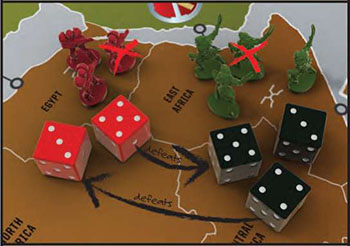
Enclave of the Bear can only send in two attackers since one must stay behind. The defender can defend to the last man. Both players roll 2 dice. In this case both the attacker's dice are higher than the defender's dice so Die Mechaniker loses his remaining two defenders.
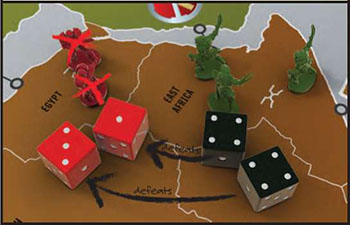
Enclave must now move his two attacking troops into the empty territory. If he had more troops in East Africa to move in, he could move them at this time. He cannot move in with his last troop as he would be abandoning that territory.
If there is no die to compare yours to, meaning you rolled 1 or 2 more dice than your opponent, then ignore that die/dice.
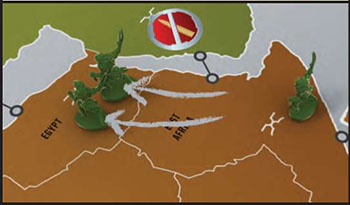
Modifying Die Rolls
Some marks on the board as well as missiles and special powers on faction cards may change the value of certain die rolls.
The effects of marks are listed on reference stickers on the game board. The following rules are in effect for all die modifications in combat:
-
Whether you are increasing or decreasing a die roll, the roll can never be higher than 6, or lower than 1.
-
If more than one die is the same number, only one is modified per Scar, Faction Power, or Missile. For example: If you are defending in a territory with a bunker and roll two 5s, only one would change to a 6 because of the bunker in your defending territory.
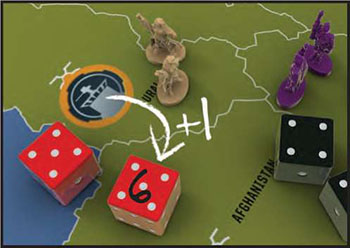
-
Sometimes, a combination of Scars, Missiles and special powers on Faction cards may affect which die is the highest one. Reevaluate your dice after all modifiers have been triggered to see which is now the highest.
Fortifications
Fortifications are energy shields that protect a city against offensive assaults. A territory with a Fortified city costs two additional troops to expand into if unoccupied.

When defending a territory with a Fortified city, the defender adds 1 to both of his dice. If the attacker attacks with 3 troops, the fortification gets worn down.
After each attack with 3 troops, mark one of the boxes around the Fortification. Once all 10 boxes have been marked, that city is no longer considered fortified.
A Fortified city (or one with a partially depleted or fully depleted Fortification) can always be refortified with a new Fortification mark. Any remaining uses on the old Fortification are wasted.
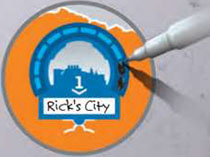
Missiles
In future games, some players may have one or more Missile tokens. These tokens can be discarded to affect die rolls in combat as noted below.
Any player (even those not involved in the battle) may discard Missile(s) after dice are rolled, but before troops are removed. For each Missile discarded in this way, the player can change one die in the combat roll to an unmodifiable 6. A player may discard multiple Missiles to change multiple dice per battle.
Players may discard Missiles in any order and may respond to another player using a Missile by using a second (or more).
If two or more players are trying to play a Missile at the same time, priority goes to the current player (attacker), then the defender, then each player clockwise around the table from the attacker.
While attacking Siberia, Khan Industries is about to lose two troops to Die Mechaniker.
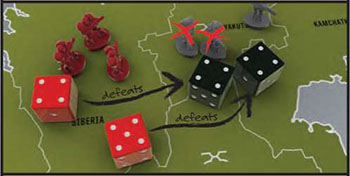
Desperate for this win, the Khan Industries player plays a Missile, changing one attack die to a 6, changing the results of the battle to one casualty each.
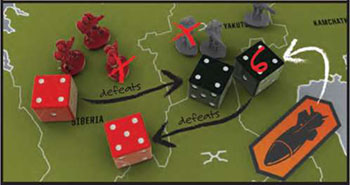
Imperial Balkania, who is not even in the battle, wants the defender to win and plays a Missile, changing one defender die to a six. This means that Khan Industries will lose both attacking troops.
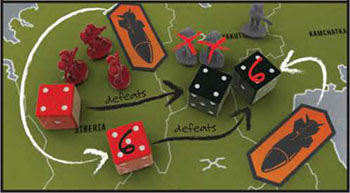
If the defender has no more troops in the territory
Move the attacking troops into the territory. You may also move in additional troops from the attacking territory at this time.
So even though you can only attack with a maximum of 3 troops, you can move more than that into the conquered territory so long as you leave at least one troop behind. No territory can ever be left abandoned because all the troops moved into a new territory.
If the conquered territory has an enemy HQ, leave the HQ in the territory. You now control that HQ and the Red Star that it is worth. If this gives you your fourth Red Star, then you win the game.
You may attack more territories if you like and are able to.
If the defender still has troops in the territory
You may attack again if you like and are able to, either between the same territories or between new ones.
Knocking out Another Player
You knock out another player if you defeat his last troop on the board. As a reward, you get all of that player's resource cards, but not his Scar card or Red Star/Missile tokens if he has any.
Depending on the state of the board, this player may or may not be able to Join the War at the start of his next turn.

4. Maneuver Troops (Optional)
After you have finished with expansions and attacks, you may maneuver your troops. Maneuvering troops is optional.
Unless you have a power that says otherwise, you can only perform one maneuver per turn.
How to maneuver: take as many troops as you'd like from one of your territories and move them to one other connected territory. Territories are considered connected if all of the territories in between are also controlled by you. You cannot pass through enemy or empty territories, and you must always leave at least 1 troop behind in the origin territory.
This is not an attack or an expansion; it is simply a movement from one of your territories to another one in order to protect your front line, or to get into a better position for your next turn.
5. End of Turn
Scars
Some Scars on the board trigger at the end of your turn. The powers on these Scars happen after any maneuvers, but before collecting a Resource or Mission card. Refer to the reference stickers on the board for more info. More Scars will become available as more packs are opened.
Drawing a card
If you attacked and conquered at least 1 territory on your turn, then you are eligible to draw 1 Resource card. You must have taken a territory from an opponent in order to draw a Resource card.
Expanding into an unoccupied territory, even one with a city, does not enable you to draw a card. Some powers give you alternative ways to get a Resource card. Unless specifically directed by an event, you can only draw 1 card per turn.
Look at the face-up Territory cards on the sideboard to see where to draw your card from.
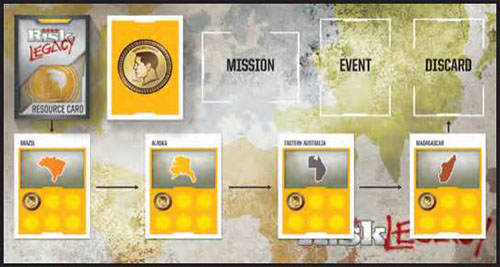
If you control one or more territories shown on the cards, then you must select one of the cards with a territory you control shown on it. The choice is yours.
Otherwise, you must draw one of the face-up Coin cards.
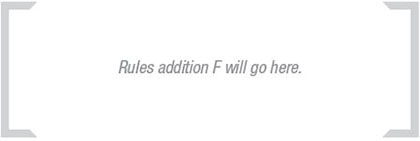
If there are no face-up Coin cards and you cannot draw any of the territories shown on the cards, then you do not get to draw a Resource card, even though you are eligible for one.
If you draw one of the face-up Territory cards, slide any Territory cards that are to the left of the now empty slot to the right and then turn over the top Territory card from the draw pile and put it into card slot 1.
If you draw a Coin card, also discard the Territory card in card slot 4. Slide the other three Territory cards to the right and turn over the top card from the Territory draw pile and put it into card slot 1.
If there are no more cards in the Territory deck, shuffle the Territory card discard pile to make a new draw pile.
When the deck of coin cards runs out
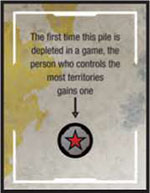
At some point in the game, the deck of Coin cards may run out. The first time this happens, follow the instructions on the sideboard to award a Red Star token to the player who controls the most territories.
If there is a tie, then no player gets a Red Star. If the deck of Coin cards runs out again in the same game, this Red Star is not awarded a second time.
Other types of cards or marks
As you play more games of Risk Legacy, different types of cards and marks will come into the game.
For your first game (at least) you can ignore the rules for Event and Mission Cards.
Event Cards
Event cards are shuffled together and placed on the noted card slot on the sideboard. At the end of your turn, after you take either a Territory or Coin card; if the newly revealed card in slot 1 has an EVEN number of resources, an event occurs.
Turn over the top card in the Event deck and perform the action on the card, including where to put the card after resolving its effect. Discarded Event cards go back in the box.
If the Event deck runs out mid-game, the Event card discard pile is NOT reshuffled to create a new event deck. However, more Event cards may come into play mid-game.
Those cards would be shuffled together with any cards left in the event deck as the game continues. You do not trigger an event when laying out the initial territory cards at the start of the game.
Note that some Event cards will be related to population or other status counts. If there is ever a tie, or if a noted faction/player is knocked out, eliminated or not in the current game; the Event does not occur. (Note: As described at the END OF GAME section, players have control over how many odd and even Territory cards are in the deck. You can directly control how often events are triggered in this world).
Conflicting Powers: Sometimes multiple powers on Faction cards or ongoing effects from Event cards will conflict. If that happens, the negative power always overrides any extra abilities a Faction has.
For example, one of the Saharan Republic's starting powers states they can maneuver between 2 territories even if they are not connected. If a power from an Event card would force Factions to maneuver only to adjacent territories, it would override the Saharan's power.
Mission Cards
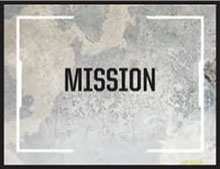
At the start of the game, randomly place one Mission card face up in the Mission card slot on the sideboard. Any player may try to complete this mission to gain one or two Red Star tokens.
At the end of your turn, if you have completed the face up mission, you may discard the Mission card back to the box and take your reward as noted (either one or two Red Star tokens).
If the game is not yet over place a new random mission in the mission slot. You can only complete one mission per turn and you cannot draw a Resource card on the same turn that you complete a mission.
Note: You can always draw a Resource card instead of completing a Mission, if you are entitled to one.

End of the Game
As soon as a player has 4 Red Stars, or if all other players are eliminated, the game is over and rewards are given out to the player who won as well as players who held on (weren't eliminated)!
The first 15 games played on this board allow both the winner and the factions that held on to change something to set up future wars in this world.
Everyone
All players should turn over their Faction cards and record whether that Faction won the game, held on (didn't win but was still in the game), or was eliminated.
If you have no troops on the board when the game ends, you are considered eliminated even if you could've Joined the War on your next turn.
If you won
The winner signs his name and dates the next line on the board. Feel free to add any slogans, comments, mottos, or trash talk as appropriate.
After that, the winner gets to do ONE of the following:
-
Name a Continent (+1 Reinforcement for you Only).

The six continents start out unnamed. You may name any unnamed continent with whatever name you see fit to give it.
If you name a continent, then that continent gives you a bonus of one more troop if you control it in future games. For example: You name South America "Awesometonia".
On this board, Awesometonia gives a bonus of 2 troops to anyone who controls it but gives you and you alone a +1 bonus for a total of 3 troops. You may put your initials here to remember you named it.
-
Name and Found a Major City (2 Population).
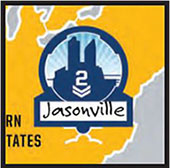
Take one of the five Major City marks and place it in any territory that does not already contain a city. Name that city.
In future games there will be a Major City there, worth a population of 2, and this territory is now considered a legal starting territory for you and you alone.
You may put your initials here to remember you founded it.
-
Cancel a Scar (Scar is destroyed).
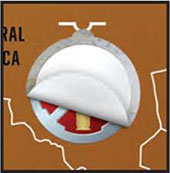
Take one of the four 'white' stickers and place it over any of the Scars that have been placed on the board.
This territory no longer has a Scar on it, and a new one can be placed on it in future games. You cannot cancel a city with this reward.
-
Change a continent bonus (+1 or -1 to that continent forever).

There are two continent marks in the game - a +1 and a -1 mark.
These are placed next to a continent bonus on the board to permanently affect that continent bonus. A continent can only be changed once (either up or down).
-
Place a fortification mark on a city (+1, +1 when defending).
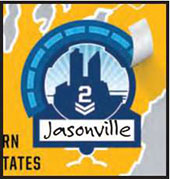
Take one of the five Fortification marks and place it on the game board encircling any city, even one that was previously fortified.
If you are covering a previous Fortification, all remaining uses on the previous Fortification are ignored.
-
Destroy a Territory Card (Card Is Destroyed).
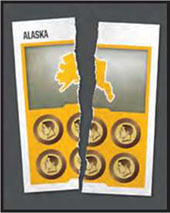
Sometimes Factions get out of control, and certain areas of the world become too strong.
Select any Territory card and DESTROY it.
Write a small "x" near that territory's name on the game board to show that it doesn't have a card anymore.
Note: there are more than 15 winner rewards as part of the game. This means that some will never get put into play.
If you held on but did not win
As the world changes around them, those Factions that held on can change their standing as well. Proceeding clockwise from the winner, each player who Held On chooses one of the following.
Note: if you were eliminated, you do not get to choose one of these options:
-
Name and Found a Minor City (+1 Population).
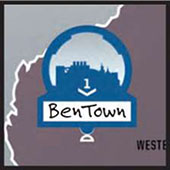
Choose a territory you controlled at the end of the game that does not already contain a city.
Take one of the nine Minor City marks and place it in that territory.
Name that city. In future games there will be a Minor City there, worth a population of 1.
-
Upgrade a Card (+1 Resource)
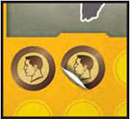
Choose a territory you controlled at the end of the game and find its matching Territory card.
Add one resource sticker to it. In future games, the resource value of this card will be worth one more.
Note: A Territory card can have no more than 6 total resources on it between starting resources and Resource stickers added, and you cannot place a Resource sticker on a Coin card.
-
If there are no more Coins or Minor Cities to place, the losers no longer gain any additional rewards.
Completed World
At the conclusion of the 15th game, once all rewards are chosen, the player who signed the victor's section of the board the most times gets to name the planet!
Fill in the section on the board under: "The World Of" with the name of the world you have created. If players are tied for most wins, those tied players roll off, adding 1 to their die roll for each continent they have named.
After 15 games, no further changes are made to the game from Winning or Holding On. The game is now played in a world entirely of the players' making. Other elements in the game, such as cards, new components, Scars, etc. will still change the world.
Legacy Key Terms
This is a glossary of terms and how they are used.
Don't worry about memorizing this right now, it's only here for your reference as you play.
Marks: Marks are stickers that go onto faction cards as well as territories on the game board. A territory is MARKED when it has any sticker on it. Otherwise, it is considered UNMARKED.
City: A city is a mark. It has a population number on it and it can be named. There are 3 types of cities: Minor Cities, Major Cities, and the World Capital. A territory can only have ONE city on it at any given time. You cannot cover an existing city with another unless otherwise noted.
Powers: A power is a mark. Powers modify Faction cards. A Faction card can only have ONE power of each type (color).
Scar: A scar is a mark. Most scars modify a territory. One scar will go onto faction cards. A territory can only have ONE Scar on it at any given time. A Faction card can only have one Scar (it will be yellow). You cannot cover an existing Scar with another one unless otherwise noted.
Natural: When text refers to a natural die roll, it is referring to the number you rolled on your die before any modifications were applied.
Controlled/Uncontrolled: You control a territory when you have one or more troops in it. You do not control a territory if your HQ is the only piece in it.
Occupied/Unoccupied: A territory is OCCUPIED when any plastic piece is in it (troop or HQ) it is UNOCCUPIED when there are no plastic pieces in it.
Discard/Destroy (a card): If a card is discarded, it is placed into its discard pile. If a card is DESTROYED, it is removed from the game permanently. Rip it up. Throw it in the trash. (Tough to do, we know). If you destroy a territory card, write a small "x" near that territory's name on the game board to show that it doesn't have a card anymore.
Remove/Lose (troops): If you REMOVE or lose a troop from the board, it goes back into your troop pile.
Demolish (a HQ): If your HQ is DEMOLISHED, put it back in the box. It is out of this game, but it can come back in future games.
Population: A city's population is the number noted on the image. A Minor City is 1, a Major City is 2, and the World Capital is 5. Your population is the sum of all the cities you control.
Continue Reading


